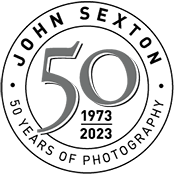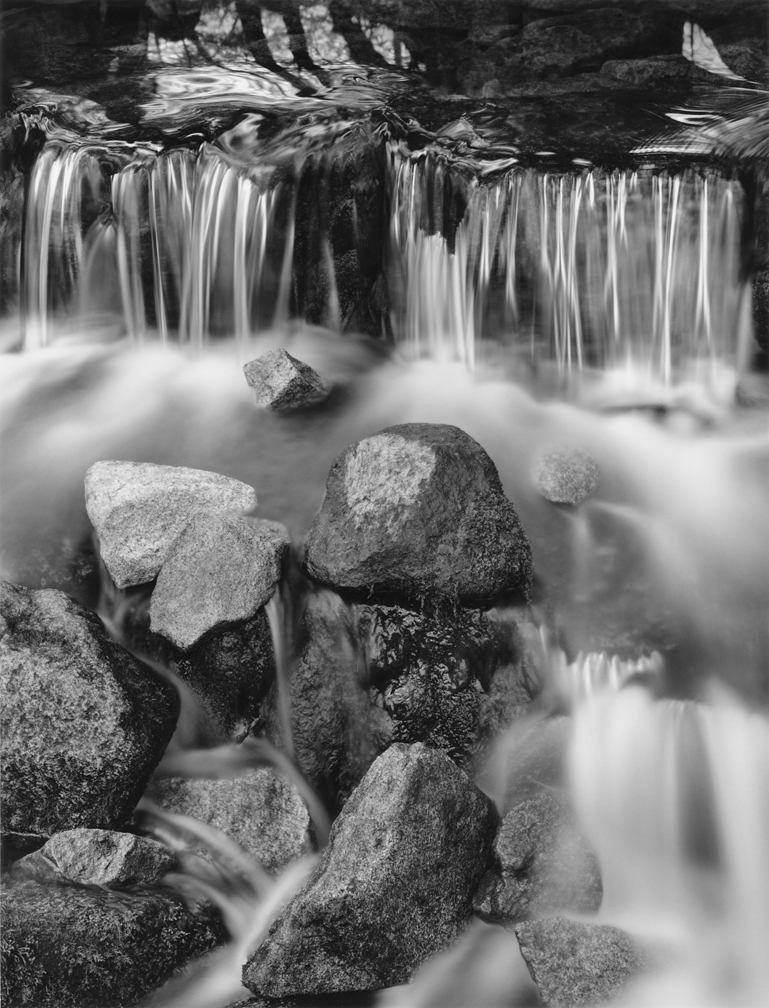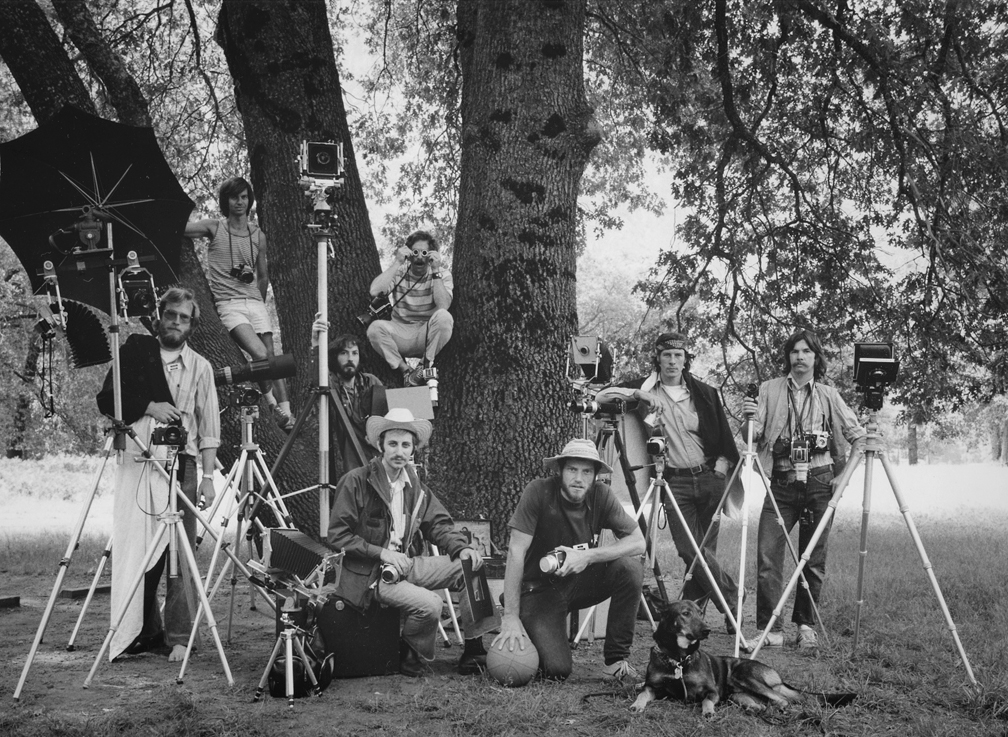ORIGINAL SILVER GELATIN PRINT BY JOHN
AVAILABLE ONLINE AT DISCOUNTED PRICE
I am pleased to welcome you to this special 50 Years in Photography edition of my periodic eNewsletter! I am also thrilled to announce a special 50 Years Limited Edition silver gelatin print of my image, Fern Spring, Yosemite Valley, California, which I made exactly 50 years ago today—on June 11th, 1973, while I was attending the annual Ansel Adams Yosemite Workshop. Fern Springs is being offered in a limited edition of 50 (It was made 50 years ago!) signed and numbered intimate-size prints, plus 5 Artist's Proofs. The print may be ordered through Saturday, June 24th, 2023 (Ansel's 1973 Workshop ended on June 24) at the very special discounted price of $300. (Tuition for Ansel's 1973 two-week Workshop was $300!) After that date, the price will increase to $750.
I made this image of Fern Spring late during the second full day of the workshop. It is the earliest image that I still print on occasion. I was excited–and frankly very surprised–that the negative turned out as successfully as it did. I included it in my first display of photographs in the Cypress College Photography Gallery as a required part of my independent study in late 1973, and it was also on display in my first gallery exhibitions in 1974. Attending Ansel's workshop not only changed my photography but changed my life. I have included information about that important experience along with my personal recollections in the article below.
Fern Spring, Happy Isles, Yosemite Valley, California
©1973 John Sexton. All rights reserved.
To learn more about the print, Fern Spring, or to place an order, follow this link:
https://store.yahoo.net/ventanaeditions/fespliedsige.html
This print will be mounted on 14x17" 2-ply museum board, with a discrete embossed stamp, denoting this is a silver gelatin print by John Sexton, in the lower right corner of the board. Following Ansel's workshop, I began exploring smaller size prints–even though I was working with a large format camera! I decided to make this print approximately the same size as when I first printed it. This intimate size print is approximately 5-7/8 x 7-5/8" in size, personally printed by me (as are all my prints), signed, numbered, and processed to current archival standards. Please note that this special 50 Years Limited Edition print will NOT be overmatted. The overmat, if you desire one, will be up to you.
To place a secure online order for this print please follow this link:
https://store.yahoo.net/ventanaeditions/fespliedsige.html
Please note that the Ventana Editions store hosting company is experiencing technical issues. If you have any difficulties placing an online order, please feel free to email or call. We will be happy handle your order directly and securely.
Prints will begin shipping on Monday, June 26, 2023. All print orders will be shipped no later than October 9, 2023.
The prints will be carefully packaged and shipped fully insured. If you have any questions about the print, please feel free to contact Anne at 831-659-3130 or email info@johnsexton.com. Our office hours are Monday through Thursday from 10 am to 1 pm Pacific time.
Anne and I want to take this opportunity to thank our many eNewsletter subscribers for the very kind responses we have received regarding our most recent mailing. If you have not had a chance to see my most recent eNewsletter you can find it here.
Thanks to all of you for following along with me over the years. Without your interest, and support, I would not be able to follow the dreams that were awakened within me half a century ago.
Cheers!
John
As I mentioned in my most recent eNewsletter attending the Ansel Adams Yosemite Workshop 50 years ago in June 1973 was a life-changing experience for me. I want to share a few more of the many fond memories I have from that transformative two-week workshop in Yosemite.
My good friend, and fellow photography major at Cypress College, John Charles Woods and I, were attending the workshop–as well as camping–together. We had both been assigned to the same workshop group–Group E. Our group spent the early afternoon hours on a directed field session with instructors at Lower Cascade Falls. I was working with a borrowed 4x5 Calumet monorail view camera and transported it in a huge fiberboard case. I had found the field session difficult and frustrating. Trying to shove the heavy awkward case over boulders as we navigated toward the base of the falls was challenging. In addition, not being practiced with the view camera in the rugged terrain, added to my frustration. I do not recall making any exposures with the 4x5 at Lower Cascade Falls.
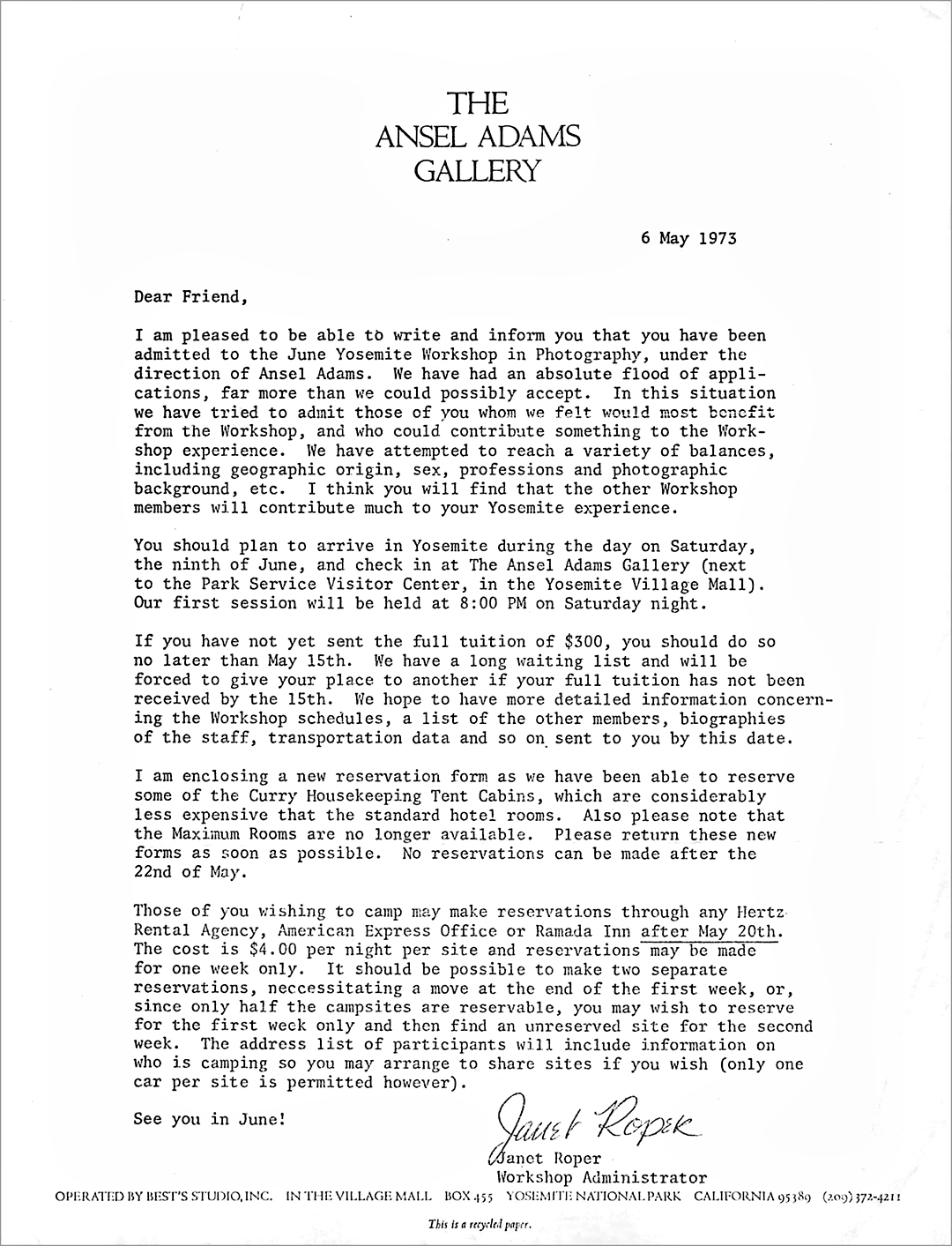
Letter acknowledging my upcoming participation in the
27th annual Ansel Adams Yosemite Workshop in Photography
As Woods and I were driving back to Yosemite Valley I suggested that we stop at Fern Spring. It is only a few feet off the road, and it was a place I was very familiar with. From the time I was two years old our annual family vacation each June was two weeks camping in Yosemite Valley. This was the highlight of my youthful life, and the ritual continued until early in my high school years. As far back as I can remember we always brought along a five-gallon metal milk can and would stop at Fern Spring to fill it up as we entered Yosemite Valley. The entire family–including me–thought that the water was particularly tasty. During our time in the Valley, we made multiple trips to this tiny spring to rejuvenate our water supply, and when we departed at the end of our two-week camping adventure we would always stop and fill up the milk can again and enjoy those five gallons of Fern Spring water after we returned home to Southern California. When Woods and I stopped at Fern Spring the sun had dropped below the massive granite cliffs above, the light was now soft on the gently water, and the place was familiar. This gave me considerably more confidence and comfort in terms of making photographs with the view camera which I had only been using in the landscape for a few months prior to the workshop.
The day before Ansel had given a lecture on the Zone System to the entire workshop group. Having had some familiarity with the Zone System and having carefully read Ansel's Basic Photo Series I was able to comprehend a reasonable amount of the information that Ansel presented, but there was plenty that was well over my head! Ansel had a unique ability as a teacher. His explanations of some of the more complex technical aspects of photography were not always easy to understand. However, in my opinion, he possessed a hidden superpower. Following such a presentation, I sometimes felt confused, but not discouraged and disappointed. Rather, I was energized to try to figure out the concepts and worked hard trying to do so. I believe it was Ansel's contagious enthusiasm that motivated students to work more diligently to understand the important information. It was also exceptionally helpful to have people like Henry Gilpin and Al Weber as workshop instructors as they were always ready, willing, and able to help decode what Ansel has said into language that were more easily understood by someone like me!
All workshop participants received a packet of information and useful materials upon arrival. In the packet was a black piece of mat board with a 4x5" cutout to be used as a viewing frame to help visualize photographs. (I still use that tool today and find it indispensable!) Exploring with my newly acquired viewing frame, I soon found an arrangement of Fern Spring that pleased me, and I set up the 4x5 camera and mounted the 210 mm lens–both of which were on loan to me from the college photography department. The college's small, flimsy, black focusing cloth was better than nothing–but not by much. I was familiar with the controls of the 4x5 camera in the studio and for working with architecture, but I was not completely comfortable with the device in the landscape. In an attempt to get everything sharp, I applied a slight front lens tilt and focused the camera as carefully as I could using my $3.00 Agfa loupe–a genuine piece of optical junk. (Later replaced with a very good quality loupe which I still use today).
Along with the viewing frame we had each been given other tools including a pad of printed exposure records to record important information about each photograph we made. This image, Fern Spring, was the first image with which I used the exposure record for as it was the first 4x5 photograph I made during the workshop. You can see my notes made exactly 50 years ago below.
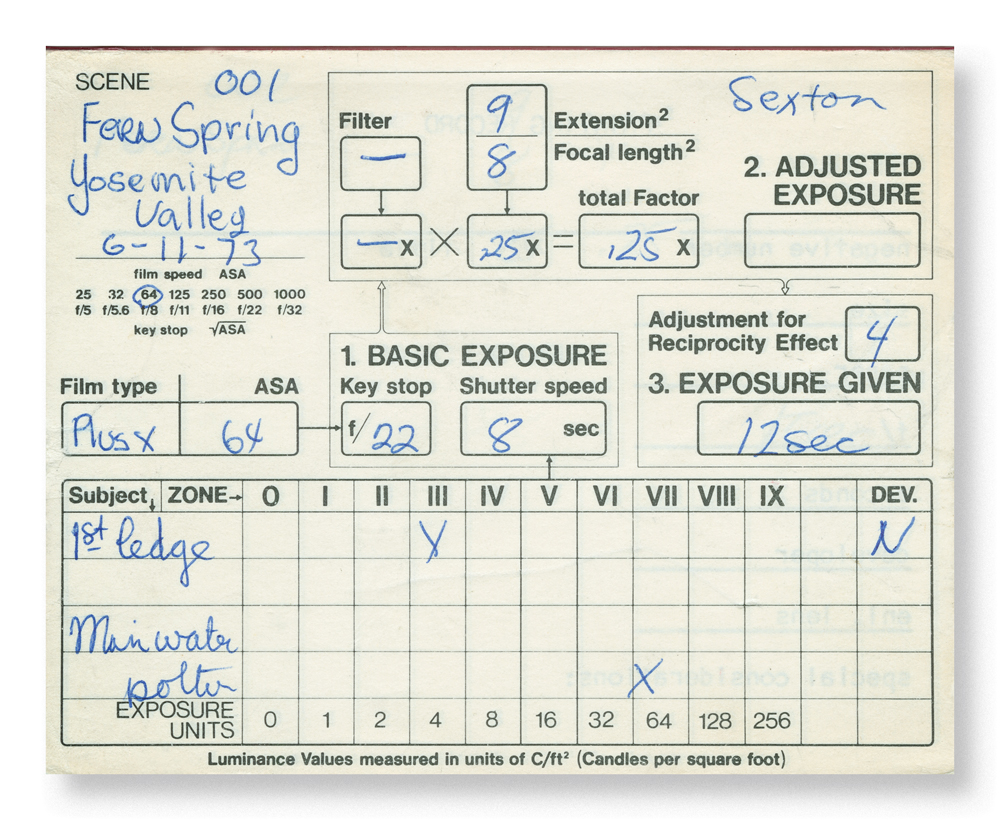
My Exposure Record Notes
Recorded just prior to making the exposure for Fern Spring
I tried to meter as carefully as I could, but this was a bit challenging as I did not own a handheld light meter at the time. Rather, I used the built-in light meter in my Minolta SRT-101 35mm camera. I took a meter reading of the dark water above where it flowed over the edge in scintillating vertical lines and placed that on Zone III. I then measured the bright water below the tiny cascade, and it fell on Zone VII. I planned and gave the film normal development. I was using 4x5 Kodak Plus-X Professional film and was rating it at an ASA (ISO) of 64 (this was based upon tests that I had done before the workshop).
I had a slight extension of the 210mm lens for which I compensated. The indicated exposure was 8 seconds at f/22. Following the Kodak recommended compensation for reciprocity departure I gave an exposure, with little confidence that it would be correct, of 12 seconds at f/22. A few months before I had seen an exhibition of photographs by Ansel Adams, Edward Weston, and Wynn Bullock. I was fascinated by the long exposures that Wynn Bullock had used with moving water and thought this was an excellent opportunity to explore that possibility.
The entire workshop was an amazing experience. Ansel was of course the leader of the workshop, and the 1973 offering was the 27th annual offering of the Ansel Adams Yosemite Workshop in Photography according to the announcement flyer. Along with Ansel, he had chosen Morley Baer, Dave Bohn, Dorr Bothwell, Henry Gilpin, Ted Orland, Ralph Putzker, and Al Weber to serve as instructors. In addition, a most talented group of dedicated photographers served as assistants during the workshop. They were Art Bacon, Mark Citret, Jim Griggs, Bob Kolbrener, Norman Locks, Alan Ross, Jon Stuart, and Guy Sussman. Along with the staff I met some amazing individuals among the workshop participants and learned a great deal from them. As an unexpected bonus, the workshop seemed to serve as a crossroad of photographers. Unannounced visitors included Brassai, Beaumont and Nancy Newhall, Jerry Uelsmann, and others! I made many friends during those two weeks. While several of the individuals listed above have joined Ansel in the final wash, I am pleased that others remain friends to this day, along with several of the 71 other workshop participants.
Assistants for the 1973 Ansel Adams Yosemite Workshop
From left to right:
Alan Ross, Jim Griggs, Norman Locks, Guy Sussman
Mark Citret, Mark's dog Herb, Art Bacon, Jon Stuart
©1973 Henry Gilpin. All rights reserved.
Special thanks to Mark Citret for providing the digital image file
That evening Woods and I found ourselves in Ted Orland's lodge room along with several other workshop participants. In addition to being an instructor at the workshop, Ted was Ansel's full-time photographic assistant in Carmel. He kindly looked through our prints providing honest, helpful, yet sometimes painful commentary. However, at the same time he encouraged us and provided constructive ideas to help us. We listened intently to Ted's comments, as well as those of all the other instructors including Ansel as the workshop progressed. Those late-night portfolio reviews were among the most valuable aspects of the entire workshop experience.
Last week I decided to open the box that contained the prints that I showed during the workshop. John Woods received much more favorable comments about his portfolio as he was decidedly more advanced and had refined his camera and darkroom printing process to a much higher level than me. As Anne and I looked through my mounted prints–which were the best I could do 50 years ago–I was astonished at how bad they are! I asked Anne, "I wonder why I just didn't give up and quit?" Anne knows better than anyone else that is just not my approach to things that are important to me. There were times during the workshop when I felt as if I was 'outclassed' by other workshop participants. Most of them were older, and seemingly more advanced than me. However, as the workshop progressed, I found, because of the generosity of the workshop instructors, assistants, and other participants, the pieces of my photographic puzzle began falling into place. This provided me with a bit more confidence with each passing day.
I had turned 20 a few weeks prior to the start of the workshop and was one of the youngest participants in attendance. As I noted above the photographic equipment I owned was limited. I had my Minolta 35mm camera with three lenses and a Hasselblad camera with an 80mm normal lens and one film magazine. The view camera and two accompanying lenses belonged to Cypress College, and I was able to borrow a Leitz Tiltall tripod for use during the workshop. I did own my own 4x5 film holders as well as a few filters. Most of the other workshop participants were much older than me and far more advanced. In addition, some of them had a considerable amount of high-quality photographic equipment. I remember seeing more than a few 8x10 Deardorff cameras. Many of the participants transported their prints in professional-looking portfolio cases. My portfolio case was a bit more modest. It was a simple pillowcase provided to me by my mom. My mounted prints fit into the pillowcase (which I still have today!). It did not provide much protection for my prints, but it was indeed 100% rag!
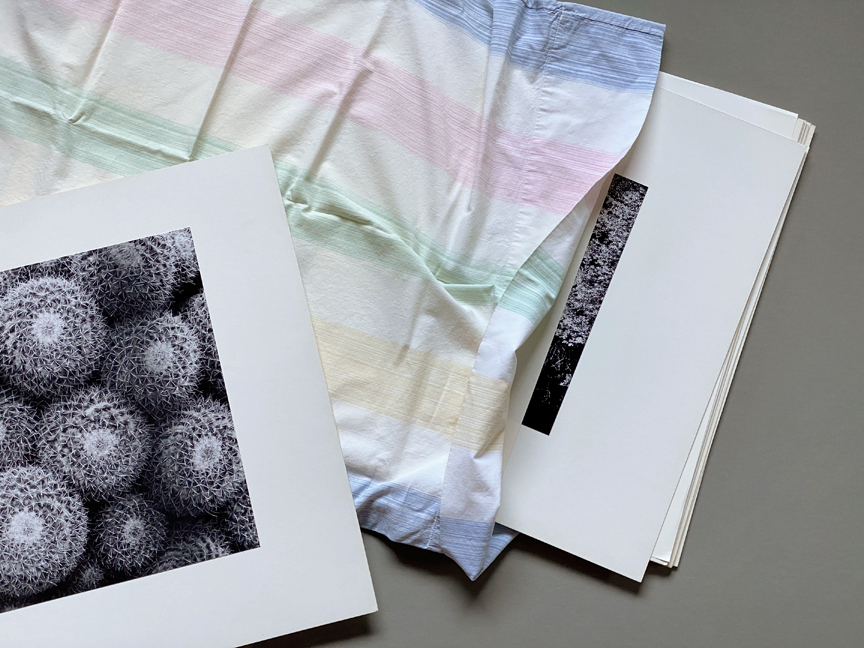
Some of my prints shown during the workshop
Complete with my one-of-kind
100% rag archival pillowcase portfolio case
Thanks mom!
I was able to discern that some of the folks who talked as if they knew a lot about photography, and had fancy photographic equipment and fancy portfolio boxes, did not always have prints that were impressive. A few were even worse than mine. This was a valuable observation for me as a young naive photographer and provided a bit of encouragement. I began to realize that it was photographers that made good photographs, not pieces of photographic equipment, or the ability to recite specific jargon. A meaningful photograph emerges from within the heart, soul, mind, and vision of the photographer. And great photographs–which we had the opportunity to see during the workshop by instructors, assistants, and other workshop participants transcended the technique and provided a positive emotional experience for the viewer–me.
Those two weeks were the most intense, exhausting, and exhilarating period of time in my 70 years. The days seemed to fly by, and sooner than desired the workshop drew to a close. The workshop was such an inspirational experience that at the conclusion of the workshop all I wanted to do was make more photographs, make better photographs, and try to make better prints. I left the workshop equipped with valuable and useful information, but even more importantly I left the workshop with my heart overflowing with inspiration! Another lasting benefit was departing Yosemite with so many new friends. Some of those individuals would become an important and essential parts of my life. I feel I was most fortunate to discover such treasures at this event organized and led by my hero, Ansel Adams, in my favorite place on this planet–Yosemite!
During that first morning of the workshop, as I was sitting nervously next to my friend John Woods, I felt ill prepared for what was about to unfold–even though we had both worked extremely hard to get ready for the event. I never imagined what gifts were ahead for me in my pursuit of my passion for photography. Had I set goals for what I hoped to accomplish working in this magical medium, they would have been too low. I expected to learn a great deal during this two-week intense workshop, and what I learned exceeded my expectations. It never crossed my mind that I might return to Ansel's Yosemite Workshops numerous times as a workshop assistant, instructor, and eventually as the Workshop Director–not to mention working full-time for Ansel as his Photographic Assistant, and later as his Technical Consultant.
Based on my experience, this is my advice for folks that want to follow their dreams...
Dream big, and live bigger!!
SOME THOUGHTS ON PHOTOGRAPHY... AND OTHER TOPICS
The role of workshops is obvious in these times when I have good reason to believe the educational opportunities for the study of serious photography are inadequate to the challenge of the young person of today. We all have a great responsibility to perfect our medium in many ways. Expressive intensity cannot function without adequate craft. We are lulled by the siren spirit of automatism and it is refreshing to observe any tendency on the part of students towards creative thinking and the development of personal craft–controls of the medium.
In the early days in Yosemite my workshops concentrated on craft and the natural scene. It gradually broadened to include many approaches to photography and led to the present structure of the workshops which I am confident is unique and rewarding. This statement applies to the entire workshop program of the Friends of Photography. My Yosemite workshops were given over a span of more than forty years. My invert youthfulness did not tolerate the heat and altitude of Yosemite and the location of the workshop was changed to Carmel in 1982. Under the direction of the Friends–which works out very well indeed.
Photography is a universal visual language and one of the most important means of communication between people of all nations.
— Ansel Adams
From Ansel's opening comments to the participants of the
1983 Ansel Adams Photography Workshops
Pebble Beach, California
The last workshops Ansel taught
Presented
July 31, 1983
